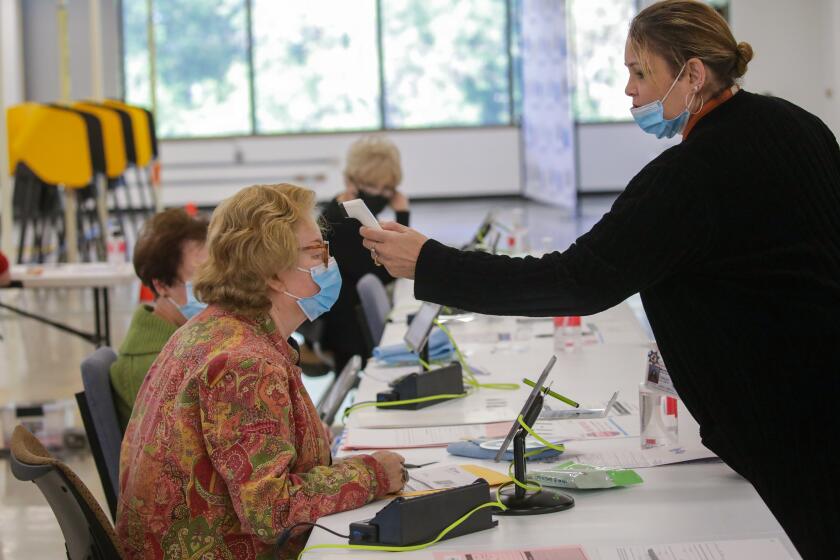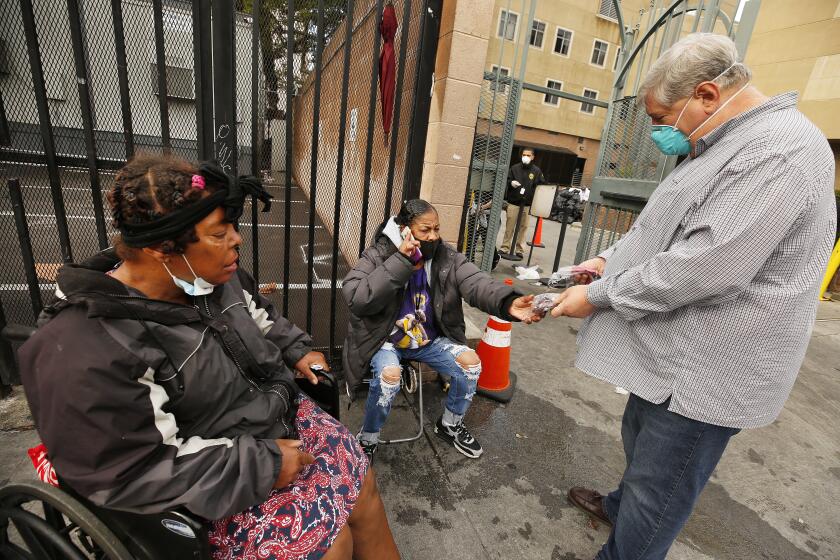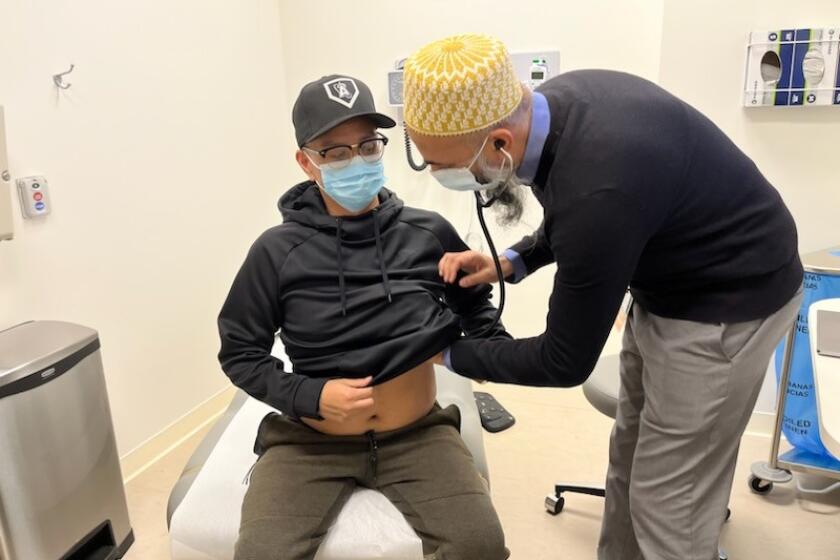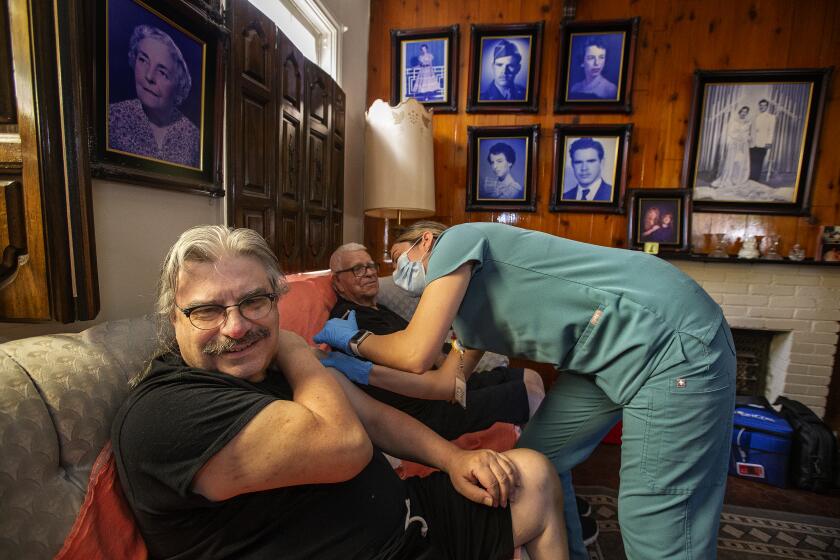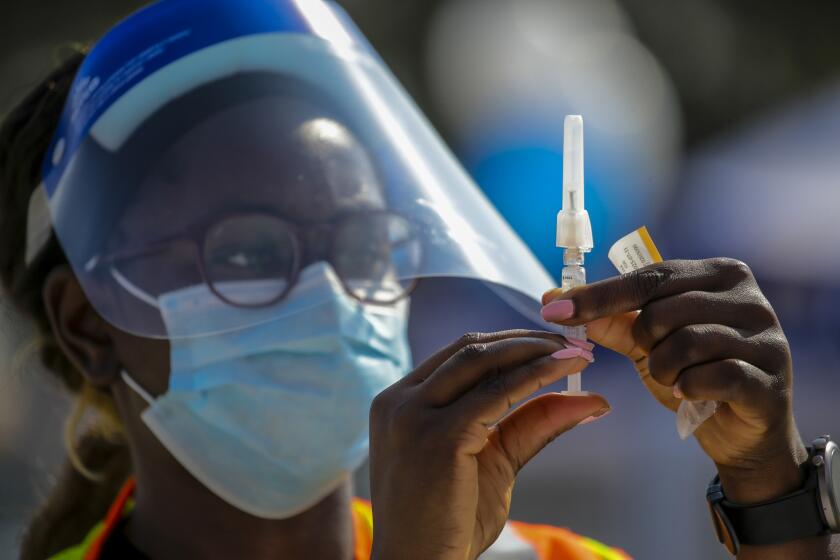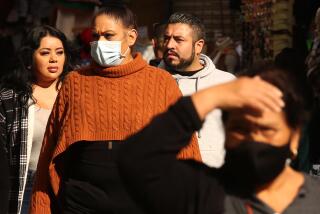Will you mask up again? A January mandate looms for L.A. if COVID-19 wave worsens
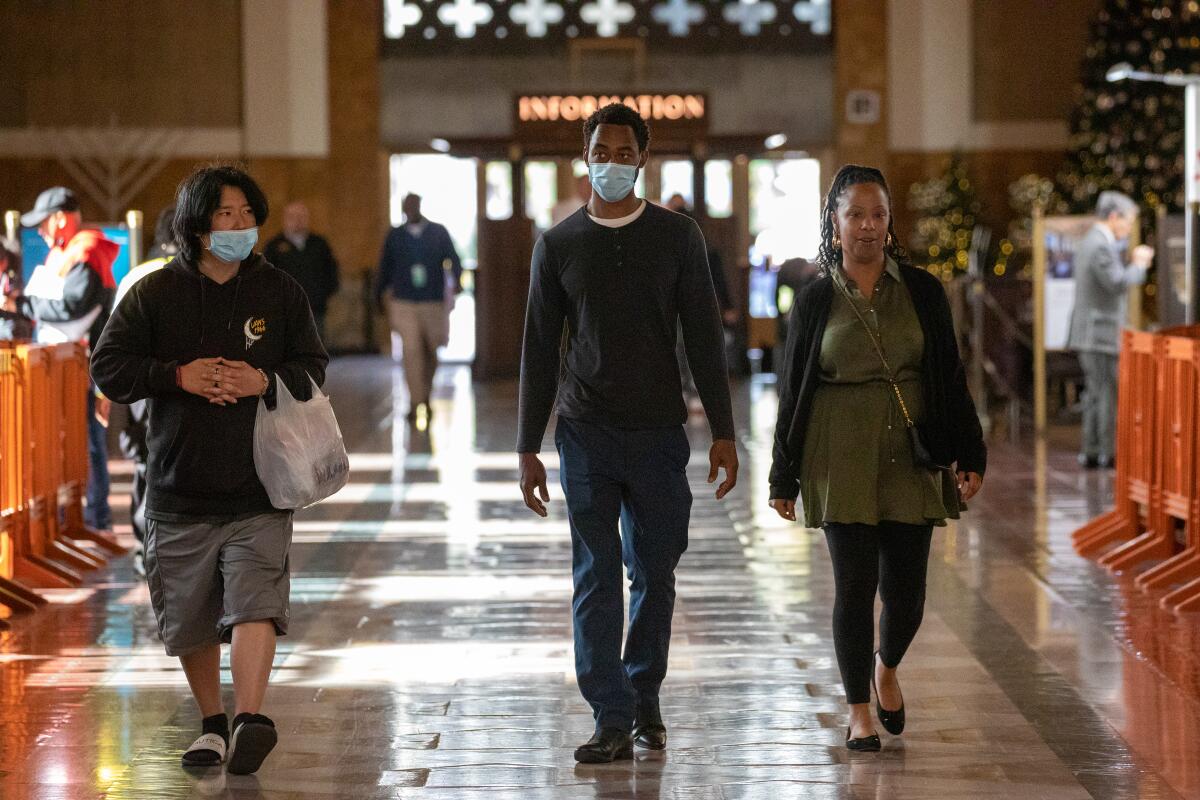
- Share via
With coronavirus cases surging and hospitalizations worsening, Los Angeles County is again facing the possibility of a renewed public indoor mask mandate.
The return of such rules, which haven’t been on the books since March, is not a given. But with the startling formation of a third straight fall-and-winter wave, officials have said a new order could be implemented shortly after the new year should hospitalizations worsen.
“We are seeing a rapid acceleration again,” L.A. County Public Health Director Barbara Ferrer said. “This is the time to put that mask back on.”
Any new indoor mask mandate hinges on two metrics related to the pressure COVID-19 is exerting on hospitals in the nation’s most populous county.
One of the two triggers, which are based on criteria developed by the U.S. Centers for Disease Control and Prevention, has already been met. The second could be weeks away, but it remains highly uncertain whether it will be reached.
Health officials warn that continued spikes in COVID-19 could bring a return to an indoor mask mandate.
The timing
A new mandate would be on the table should 10% of all staffed inpatient hospital beds in L.A. County be filled with coronavirus-positive patients. That has happened for a sustained period of time only twice in the pandemic — both during the last two deadly winter surges.
According to the most recent data, 6.9% of hospital beds in L.A. County are being used by coronavirus-positive patients, up from 2% at the start of November. Trends from the preceding two weeks suggested the figure could hit 10% around Dec. 19, Ferrer said Tuesday.
But several days of improving data since then are pushing that estimate back, Ferrer said Thursday, and it’s still possible L.A. County won’t reach that threshold at all.
L.A. County officially reassesses its data every Thursday, the same day the CDC issues its weekly report. So, for instance, should L.A. County be above that threshold on Dec. 22 — and remain so for two weeks — a mask mandate would be announced Jan. 5 and go into effect a day later.
The mandate could be canceled if cases and hospitalizations stabilize or decrease. Or it could come sooner if conditions deteriorate faster than expected.
New hospitalizations have tripled in the last month. A new mask order is possible in the coming weeks if hospitalization metrics worsen.
Why not move faster?
Ferrer said she is strongly recommending people put their masks back on now in indoor public settings.
But she says a two-week waiting period before any potential order is issued is important to give businesses the time to educate their workforce and post appropriate signage.
“In order for this to be an effective strategy that allows there to be as high compliance as we can get, you do need to give people time,” she said.
Ferrer said the mandate generally relies on voluntary compliance. Even at schools, she said, parents are eligible to get exemptions for their children “if there’s a health or safety issue that affects that child.”
When everyone around them stops taking pandemic precautions, it gets harder for immunocompromised Americans to protect themselves against COVID.
Will people really be willing to mask up — again?
While Ferrer routinely wears a mask in indoor public settings, she’s “very aware” that few others do.
“It will be really hard to get back into putting on face coverings. Nobody really likes them. We understand that,” Ferrer said.
But she thinks a mask order is worth it and, if implemented, it will be for only a short time.
Some essential workers are supportive of mask mandates, she added, noting the potential disruptions during high transmission.
“I’m just not sure that it’s a smart move to give up and throw up our hands,” Ferrer said. “Mortality [for COVID-19] is still higher than it is for influenza, certainly than the common cold, and most other respiratory illnesses.”
A confluence of respiratory illnesses has some California officials warning of a possible triple threat that could strain healthcare systems.
Why is L.A. County considering this?
COVID-19 has carved a deadly path through L.A. County, and its cumulative per capita death rate is one of the worst in the state.
A major reason is that L.A. — which has the the largest population and gross domestic product of any county in the nation — is structurally vulnerable to pandemics.
Los Angeles is the nation’s most crowded place to live, as a recent Times analysis documented. That report also found L.A.’s most overcrowded neighborhoods have experienced COVID-19 death rates at least twice as high as those with ample housing.
Although the area is known as a place with sprawling neighborhoods of single-family houses, it is also home to many where families squeeze into tiny apartments. The Times analysis found more homes are overcrowded in Los Angeles than in any other large U.S. county, a distinction that carried deadly consequences.
Officials have also long noted how wealth, poverty and race can dramatically affect the toll the coronavirus exacts on a community. People who live in areas with higher rates of poverty are more likely to end up being hospitalized than those in wealthier communities.
Such inequities have been present throughout the pandemic, but are exacerbated when transmission spikes.
Whenever a surge happens, officials expect COVID-19 will hit harder in communities with fewer resources. But protective measures such as widespread masking would help reduce the spread of disease, according to Ferrer.
“We look at the evidence — and it’s very, very compelling — that if people do wear well-fitting, high-filtration masks, they have more protection. And they afford others more protection from transmission,” she said.
Looking for an easy way to reduce your risk of catching a viral illness? Try to stop touching your face.
Is anyone else contemplating a mask order?
No other counties have publicly committed to a mask mandate should conditions deteriorate. State officials also have said a new order is not being considered at this time — though they continue to recommend masking in indoor public settings.
“Given the trajectory and the trends that we see now, we’re hopeful that we’ll be able to use masks on top of other tools to keep numbers manageable enough, although health systems certainly have been strained,” said Dr. Mark Ghaly, California‘s health and human services secretary.
Dr. Sara Cody, Santa Clara County’s public health director and health officer, said she doesn’t expect to issue a mask order. Both her county and L.A. had local mask orders from summer 2021 through early March.
“I don’t see mandates returning. I think that three years in, it is extraordinarily difficult to mandate,” Cody said Tuesday. “And I think that we all have information, and we all have tools and we all have access to the tools. Everyone has access to masking.”
But she also urged people who are inclined to wear a mask to do so.
The pandemic hasn’t hit Santa Clara County nearly as hard as L.A., however. In Santa Clara County, 6.9% of residents live below the poverty line, half of L.A. County’s 14.2%. Santa Clara County also has reported much higher COVID-19 vaccination rates.
Santa Clara County never encountered the kind of strain to its hospital system that L.A. County did during its first winter wave, when hospital morgues were so overwhelmed that the National Guard was called in to help with the overflow of corpses.
And in both winter waves, L.A. County’s death rate remained significantly higher than Santa Clara County’s. Between December 2020 and May 2021, L.A. County’s death rate was 165 for every 100,000 residents, double Santa Clara County’s rate of 84.
Even in the first Omicron wave, L.A. County was hit harder. Between December 2021 and May 2022, L.A. County recorded 49 deaths for every 100,000 residents; Santa Clara County posted 20.
Cases and hospitalizations are climbing rapidly, raising the possibility of a renewed public indoor mask mandate.
What’s the potential risk?
Along with COVID-19, flu and respiratory syncytial virus, or RSV, also are circulating at high levels this year — sparking concern that hospitals could be stressed by a “tripledemic” of diseases. Strain on hospitals could make it harder for people to obtain life-saving healthcare, Ferrer said, “and we want to prevent that as much as we can.”
“The number of people being hospitalized and the rates of hospitalization — that’s not really encouraging at the moment,” she said. “And our hospitals have to deal with the corresponding staffing shortages that happen when you have lots of illnesses.”
Already, children’s hospitals across California have been stressed by high rates of RSV and other viral illnesses, sometimes so inundated they can’t accept transfers from other facilities. In Fresno County, the strain has extended to adult hospitals, and some facilities are “working over capacity and their emergency rooms are close to disaster levels,” the local public health department said.
“Hospitals across the state are working to add pediatric beds as quickly as possible, but the number of children who need hospitalization is currently outpacing their ability to expand,” the California Department of Public Health said in a statement Tuesday. “Hospitals typically have about 35% to 40% open pediatric intensive care unit beds, but that number is down to about 20% statewide. It’s even lower — below 12% — in some regions of the state.”
More to Read
Sign up for Essential California
The most important California stories and recommendations in your inbox every morning.
You may occasionally receive promotional content from the Los Angeles Times.
